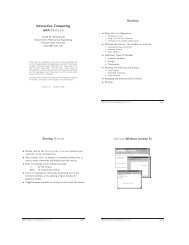"O Soul, Come Back!" A Study in The Changing Conceptions of The ...
"O Soul, Come Back!" A Study in The Changing Conceptions of The ...
"O Soul, Come Back!" A Study in The Changing Conceptions of The ...
You also want an ePaper? Increase the reach of your titles
YUMPU automatically turns print PDFs into web optimized ePapers that Google loves.
SOUL AND AFTERLIFE 365THE RITUALOF FUIn Han Ch<strong>in</strong>a there was an important death ritual called fu,"<strong>The</strong> Summons <strong>of</strong> the <strong>Soul</strong>." It was the first <strong>of</strong> a series <strong>of</strong> rituals tobe performed to the newly dead. Although thisfu ritual, as variouslyreported <strong>in</strong> the Chou-li N I-li fW, and Li-chi is a highly complexone, it may nevertheless be briefly described. As soon as a persondies, a "summoner" (fu-che ) normally a member <strong>of</strong> the familyclimbs from the east eaves to the top <strong>of</strong> the ro<strong>of</strong> with a set <strong>of</strong> clothesbelong<strong>in</strong>g to the deceased. <strong>The</strong> summoner faces the north, wavesthe clothes <strong>of</strong> the deceased, and calls him by name aloud- "O!Thou so-and-so, come back! " After the call has been repeated threetimes, the summoner throws down the clothes, which are receivedby another person on the ground. <strong>The</strong> receiver then spreads theclothes over the body <strong>of</strong> the dead. Afterwards, the summonerdescends from the west eaves. Thus the ritual <strong>of</strong>fu is completed.Accord<strong>in</strong>g to the Han commentator Cheng Hsuan *A (127-200)the purpose <strong>of</strong> thefu ritual is "to summon the hun-soul <strong>of</strong> the deadback to reunite with its p 'o soul" (chao-hunfu-p'o TBAMR). In fact,the ritual is predicated on the belief that when the hun separatesfrom the p 'o and leaves the human body, life comes to an end. However,at the moment when death first occurs, the liv<strong>in</strong>g cannot bearto believe that their beloved one has really left them for good. <strong>The</strong>liv<strong>in</strong>g must first assume that the departure <strong>of</strong> the hun-soul is onlytemporary. It is possible, then, that if the departed soul can be summonedback the dead may be brought back to life. A person can bepronounced dead only when the fu ritual has failed to achieve itspurpose, after which the body <strong>of</strong> the dead will be placed on the bed<strong>in</strong> his or her own chamber and covered with a burial shroud calledhu orfu W.3Remarkably, this Han ritual practice has been confirmed by recentarchaeological discoveries. In 1972-74, three Han tombs were3 On the ritual <strong>of</strong>fu T, see Li-chi chu-su lliffItg (Shih-san ch<strong>in</strong>g chu-su ++j:,, 1815edition), 4.20b, 21.9b-lla, 44.3a-5a; Hu P'ei-hui iI, I-li cheng-i 'IEI (Kuo-hsuehchi-pen ts'ung-shu RWJ 4,4: edition, hereafter KHCP), 26.2-6; Sun I-jang N ,W Chou-licheng-i Wi10IE4 (KHCP), 5.16.20-22. Consult also James Legge, tr., <strong>The</strong> Texts <strong>of</strong> ConfucianismPart III: <strong>The</strong> Li Ki, 2 vols. (Sacred Books <strong>of</strong> the East, ed. F. Max Muller), 1:368-69; JohnSteele, tr. <strong>The</strong> I-li or Book <strong>of</strong> Etiquette and Ceremonial (London: Probstha<strong>in</strong> & Co., 1917), 1:45.















